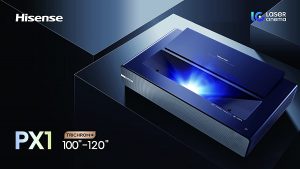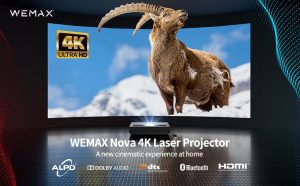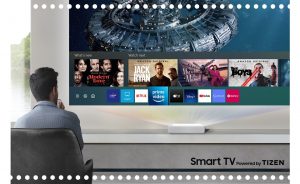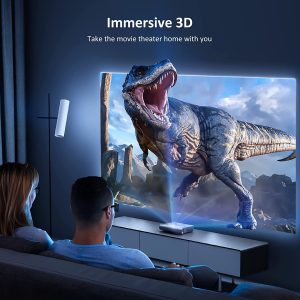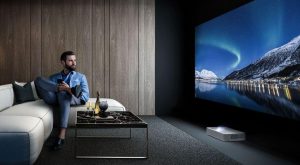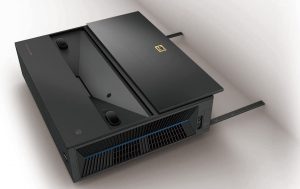When talking about Formovie, many people may be confused. Where does this brand come from? In fact, this is a joint venture between Appotronics, the king of laser projection, and Xiaomi, a famous digital brand. Appotronics also has its own independent brand WEMAX, and its best-selling WEMAX Nova 4K is widely praised. The Cinema 2, a machine owned by Formovie in this review, is a product of the same company. In fact, it uses similar technologies. The performance of the two machines is referential.
According to my understanding of Appotronics, WEMAX Nova 4K and Formovie Cinema 2 have the same hardware and slightly different software. WEMAX Nova 4K is oriented to the global market, while Formovie C2 is only sold in China. So the hardware part of the following review can also be considered as the review of WEMAX Nova 4K.

At present, the ALPD laser display technology of Appotronics has developed for four generations. According to the principle of using one generation, researching and developing one generation, and reserving one generation for general technology enterprises, ALPD4.0 is currently used to impact the high-end market, while 3.0 is just in the period of impact on the general consumer market. This is also the main line of today’s article. I will introduce Formovie C2 laser TV with ALPD3.0 laser display technology in detail through the disassembly review.
Unpacking

Those who have some basic knowledge of optics should know that laser light source is characterized by high purity and low dispersion, so laser light source technology is commonly used in short focus projection and laser television. To be honest, I think there is no difference between them in essence, but laser TV is better than fixed focus projection, pursuing the perfection of the picture, while short focus projector is good at zooming, mainly pursuing the strong adaptability of different projection surfaces.

The protagonist of this review is the Cinema 2 laser TV product produced by Formovie. This machine has many highlights, including ALPD3.0 laser fluorescence display technology, true 4K resolution, 3000:1 contrast, 2200ANSI true lumens, MEMC motion compensation, HDR10+decoding, Dolby, DTS double decoding, etc.

After reading these parameters, I found that this machine is actually similar to WEMAX Nova 4K. See the following table for main parameters:
| Formovie Cinema 2 | WEMAX Nova 4K | |
| Optical Solution | ALPD 3.0 | ALPD 3.0 |
| Resolution | 4K | 4K |
| Contrast | 3000:1 | 3000:1 |
| Brightness | 2200 ANSI Lumens | 2100 ANSI Lumens |
| MEMC | Yes | Yes |
| HDR | HDR10+ | HDR10 |
| Audio | Dolby, DTS double decoding | Dolby Audio and DTS-HD sound |


The main unit of Formovie C2 is very small in size. Its three dimensions are only 456mm x 308mm x 91mm. It is the smallest of the common 100 inch laser TV hosts on the market. The mainframe continues the modeling design of the previous generation 4K Cinema, which has won many international authoritative ID design awards. It looks very fashionable and can easily integrate various living room decoration styles. The front of the host is designed with an acoustic mask. Under the black perforated mesh cover, the outline of the four sound units can be seen faintly.

Viewed from the top of the host, the strong white square shape complements the black projection window. Especially with the golden peak meter LOGO in the middle of the fuselage, the composition of the golden triangle looks very balanced.

Compared with ordinary projectors, the bottom of the fuselage is much simpler. In addition to three rubber feet, there are four fixing screws for hoisting.

The rear of the fuselage is a common interface area for laser TVs. Formovie C2 has three HDMI2.0 interfaces, two USB2.0 interfaces, one analog audio output, one optical fiber output and one gigabit network interface. It is a relatively rich configuration in the television industry.

The side of the fuselage adopts a full opening design, which lays a good foundation for the heat dissipation of the host. The hidden third USB interface can also be seen on the base, which is convenient for daily use. Next to the USB interface is the foot height adjustment knob.
The height adjustment range of the foot is about 1CM, which is more than enough for the laser TV used in fixed stands. After all, no one’s TV cabinet will have such a large horizontal error.
Internal Structure

The most brilliant part of the fuselage of Formovie C2 is the stepped design at the edge of the projection window. Every time I see this window, I will think of the famous open-air theater in ancient Greece. The black window is like the central stage, and the steps at the edge are the auditorium.
The runway window in the above figure is not only a decoration, but also a human body sensor window. After the eye protection function is turned on, it will automatically enter a low-power state as long as it detects that the human body is approaching, so as to avoid laser burns to the eyes.

Dismantle the shell of the host, and when you look at the front of the host, Formovie C2 looks like a Sound Bar in this direction. This is also a highlight of Formovie C2 laser TV. Its built-in dual full frequency+dual high-frequency four speakers are 30W in total, which can compete with the real Sound Bar in appearance and performance.

Take a closer look at its two loudspeakers. The high-frequency unit on the left adopts the soft top design commonly used by Japanese. The high-frequency response is soft and not harsh, while the full frequency unit is a composite fiber basin. The medium frequency performance of the unit made of this material is better. The low-frequency is not its strong point because of its diameter, but the rubber edge design will make the low-frequency response more elastic, that is, it is often said to be crisp and not stuffy.

The left and right units are installed on the special speaker with a capacity of 1.5L, and the speaker is connected to the host through rubber shock absorption. This independent suspension box is designed for high-end models. It not only has good sound quality, but also does not cause resonance noise due to high volume.

After seeing the speaker, let’s turn our attention back to the real core ALPD in the mainframe. From this picture, the internal cleanliness of Formovie’s products is convincing. At first, it is a typical Internet technology enterprise product, full of IT flavor.

On a large heat sink inside the product, you can see a very striking ALPD logo, which is the core technology device from Appotronics.

This aluminum alloy device with dense heat dissipation synapses cast on the surface is the source of ALPD display technology – laser generator. This technology specially developed for digital projectors not only improves the luminous efficiency by 20% compared with the previous generation, but also supports 2200ANSI lumen picture brightness and 110% Rec.709 color gamut. ALPD has a long life and is the most powerful device of the whole machine. It can be seen that the peak meter projection is very concerned about its heat dissipation design.

In addition to the heat dissipation bulge on the aluminum shell, the engineers at the rear and side of the aluminum shell also designed a very large L-shaped heat pipe radiator to dissipate heat for this laser light source.

There are three cooling fans inside the machine, which are designed to push and pull. The fans are actually famous Japanese electric products. It seems that the quality must be quite good.

From the laser light source comes TI’s DMD chip and projection lens. Formovie C2 adopts the full optical path and full closed design, which is durable and not easy to dust. The black cylinder in the middle is a lens designed with a large depth of field and a small aperture. Those who have photography foundation should understand that this lens can keep the focus in a relatively large range, which is very convenient to adjust the focus. In addition, the electric focusing mechanism can be vaguely seen on the right side of the lens. Yes, although the projection depth of Formovie C2 is large, it still supports electric focusing.

Next to the DMD chip is its driver board. According to the manufacturer’s information, Formovie C2 uses TI’s 0.47 chip, which is also a very common DLP chip in domestic economical 4K projection. If there is any difference between Formovie, I think the manufacturing quality of its driving board is really high.

The drive board is covered with a metal shield that integrates heat dissipation and shielding, and the main chips are included in the protection area.

This is the full picture of the drive board with the shield removed. It seems that the workmanship is excellent, the chip layout is reasonable, and the welding quality is excellent, which is typical of a large IT factory.

The core of the driver board is the TI’s DLPC6540 digital display controller. This guy supports 4K 60Hz UHD display and up to 240Hz at 1080P. It provides a single V-by One HS video input port with one, two, four or eight channels. The pixel clock supports up to 600MHz, the input transmission rate is up to 3.0Gbps, and supports RGB and YCbCr input formats. It is the most commonly used DLP driver at present.

There is also an STM32 MCU on the driver board. Generally speaking, this guy is mainly responsible for all kinds of encoding and decoding work, including HDR10+decoding supported by Formovie.

There are a lot of empty seats and spare interfaces on this drive board. It can be imagined that Formovie adopts a unified design. Different models use this drive board. There are also two hidden buttons on the board. Guess what they are.

Continue to remove the drive board. The next exposed piece is the genuine motherboard. At present, all smart TV products have built-in operating systems. As an Internet enterprise, Formovie is naturally better at this area. Therefore, the performance of the C2 motherboard is worth seeing.

The soc and memory device are located in the center of the motherboard. Formovie C2 adopts Amlogic T972 chip, which is very common in smart TVs. It supports up to 8K@24fps decode. In terms of storage, 2G DDR4 RAM memory+16G emmc high-speed flash memory is also at the middle level.

It’s interesting to say that the T972 chip used by Formovie C2 does not support MEMC, so it specially introduces a Yonglian NT72353 to complete this task. With the help of this MEMC dedicated IC, the frame insertion capability of Formovie C2 is not only no less than that of T1 MT9669, but also slightly more than that of T1.

There is also a very important chip on the motherboard. It is the RTL8822CS dual band gigabit wifi+BT module produced by Little Crab. It supports the 11ac specification and the 2T2R dual antenna Bluetooth 5.0. With this chip, the wireless connection function of Formovie C2 is also quite strong. You should know that 5GWIFI is the most basic requirement to play 4K videos smoothly.
Use Experience
After Formovie C2 gets home, because this machine supports electric focusing, it can adjust the picture size within a certain range, instead of the fixed screen size that must be projected like traditional laser TVs. In order to better demonstrate the machine performance, I chose to do the next real machine test on the 170 inch projection screen at home.
It must be noted here that strictly speaking, the laser TV needs to be matched with a dedicated anti light Fresnel hard screen to give full play to its optimal effect. However, due to the limitations of my family, it can only be tested on this electric wave bead screen for the time being. This screen is hell for the short focus projector. First, the optical characteristics of the wave bead screen. The angle between the short focus projector’s projection angle and the user’s viewing angle is about 80 degrees, At this angle, the gain of the wave bead screen is not 2.5, but about negative 0.6. Secondly, because this screen is a rolling screen, it is not smooth in any way, and the distortion of the picture when the short focus machine is cast at a large angle will be magnified.

What is the concept of ultra short projection ratio 0.23:1 of peak meter C2? The host is basically placed close to the screen. During viewing, people can walk around freely without worrying about blocking the screen like ordinary projection.
The startup process of the machine is very refreshing, during which there is no advertisement disturbing people. After the startup, the machine directly enters the home page of FengOS, which is developed by Formovie.

After startup, it is naturally the general setting of projection products. Formovie C2 needs to do two picture settings, one is geometric correction and the other is focus setting. The geometric effect of the picture is achieved through the 8 point adjustment on the left. Of course, if the placement of the host is particularly ideal, you can also switch to the normal 4 point correction mode.
It must be mentioned here that with the help of Formovie C2, even though the screen gain has dropped to 0.6, the brightness of the whole picture is still very high and uniform, and there is no dark angle that can be detected by the naked eye. This is a major advantage of using laser light source in Formovie C2. But unfortunately, although I have carefully adjusted it, the flatness of the screen is too poor, and the local distortion of the picture is obvious. If it is on a special anti light screen, its flatness and brightness will be much more beautiful.

After booting up, Formovie C2 gave me an obvious feeling that the real brightness of the screen was very high. The contrast picture of turning the lights on and off when the projection size is about 120 inches. You can see that the gap between them is not very big. With the 2200ANSI brightness of Formovie C2, only the gray level outside the screen drops after the light is turned on. The difference between the brightness and the brightness of the projection screen is very small. If the Fresnel hard screen dedicated to laser TV is used, the effect will be better when the light is turned on.
Formovie C2 supports the standard 4K resolution, so the first thing to do is the standard resolution test. From this classic 4K test map, even the smallest text can be basically clear, and the machine’s 4K capability is beyond doubt.
The two test maps of tone level restoration and color performance are also used for TV testing. From the results, the picture feels very good. There is no fault in either tone level or color level, and the transition area is very soft.

As I said just now when adjusting the screen, the picture brightness uniformity of Formovie C2 is very good. It can be seen from this side shot that the color and brightness of the screen are consistent with that of the whole screen. The brightness of the whole screen is very uniform without dark corners. It can be said that the lens quality is also quite high.
It is not accurate to just look at the static test picture. It is amazing to let the picture move. When playing this test film, Formovie C2 threw an excellent picture texture, and there was almost no difference between the appearance of the LCD TV at home when the lights were turned off. Of course, there is no difference here, just for the brightness and chromaticity quality of the picture. The 120 inch picture of Formovie is still much stronger than my 75 inch LCD.
Formovie C2 supports HDR10+decoding. The picture contrast of 3000:1 makes me feel like I need to cover my eyes when the sun shines from the buildings. However, if you carefully observe, you will find that the details of the building’s sunny side are also clear, and it has not become a dead black mass. The contrast of the ALPD laser display technology as high as 3000:1 is also fully reflected in the image expressiveness. For example, this video is typical of bright and dark. Whether it is the highlight from the gloves or the details of the background shadow, Formovie C2 can display very well.
Formovie C2 has a 110% Rec.709 color gamut. Many people like to get a colorful picture to show the color gamut when evaluating, which is actually wrong. The advantages of high color gamut can only be truly shown in this kind of film with light and single screen color. Those subtle color differences are very easy to produce color fault with ordinary projection, while the C2 of Formovie is good.
Of course, because Formovie C2 supports Dolby and DTS decoding, its sound effect is also good. The dual full frequency+dual high frequency sound with a total of 30W can produce a pop like sound wave. Although the low frequency band is slightly vague, it is enough to set off the atmosphere for watching blockbusters.
Of course, with such good sound quality, you can’t just watch TV at ordinary times, right. The speaker of Formovie C2 can also be used as an independent Bluetooth speaker, which can be connected with a mobile phone and play music. The machine also provides the screen closing function, making its power consumption closer to that of an ordinary Bluetooth speaker.
When disassembling the machine, it was mentioned that the machine supports MEMC motion picture compensation function. The switch of this function can also be found in the system settings, which can be set in three levels. According to the current TV performance classification, only the TV with this function can be rated as a high-end product.
In terms of external interfaces, the machine supports HDMI input, and also supports playing the USB flash disk content connected to the USB port. Of course, these are the basic functions that modern televisions should have. What is really commendable is that Formovie C2 has a very good screen projection function. It can support almost all the protocols that can be seen in the market, that is, as long as your equipment supports screen projection, you can definitely project to Formovie C2.
Summary

Formovie C2 is an economical laser TV used to impact ordinary household users in the current Formovie product line. Its efforts in cost performance have overturned my traditional values of 100 inch laser TV, especially the C2 screen kit, which has created a new low price for similar products. Each parameter is slightly lower than the higher T1, but the manufacturer controls the gap between them to be very small. It can be said that if you are not an extreme audio-visual parameter party, you can hardly feel the difference between the two machines in daily use.
Compared with the ordinary laser TV, Formovie C2 has the adjustable focal length function, which makes its requirements for the screen slightly lower than the traditional laser TV. It can be used with either a dedicated Fresnel anti light screen or an ordinary projection screen (but it must be flat, preferably a hard frame screen), which makes the user’s choice more flexible. Those with less money can first enter the host to feel the advantages of a large screen. You should know that the thousands of dollars you have invested in the screen are basically used for anti light, and there is no difference between turning off the lights in a dark environment and turning off the lights by hand.
Finally, I’d like to make a little suggestion. Although the machine has provided enough expansion interfaces, its three USB interfaces are only common 2.0 versions, which is a bottleneck for playing 4K or even 8K bit rate files in the USB flash disk. I hope the manufacturer can provide at least one USB 3.0 interface to supplement the last 4K short board of this TV.




